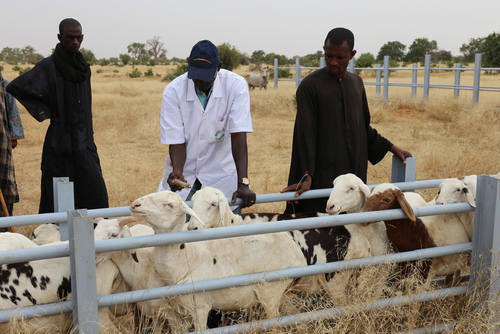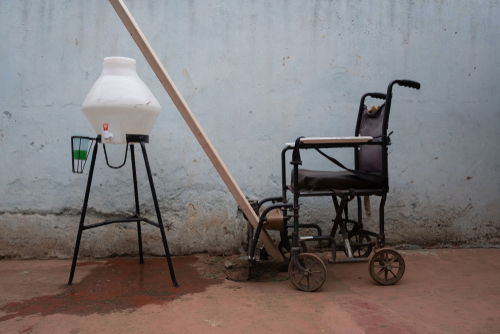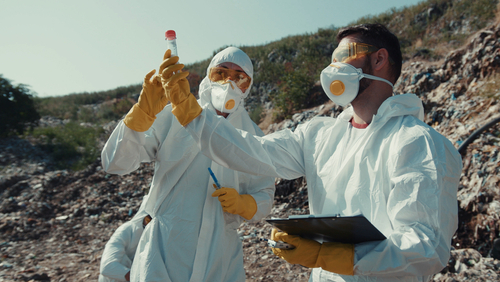October 23, 2023

Data from low- and middle-income countries show the value of vaccines to help control drug resistance.
A recent report by One Health Trust highlights the importance of boosting vaccination coverage to slow the pace of antimicrobial resistance and reduce its health and economic burden in low- and middle-income countries. The report promotes the use of country-specific data and underscores the need for policymakers to use the available evidence base to inform investments in new vaccine introductions and coverage expansions. [OHT]
Women and children’s respiratory health and indoor air pollution in India
In mid-August, researchers from One Health Trust (OHT) and Merck Sharp & Dohme (MSD) came together to kick off a pilot study on the effect of indoor air pollution on women and children’s health in India. In an OHT blog post, Rishiraj Bhagawati details how researchers, program officers, and data collectors traveled through the Chikkaballapur district in the Indian state of Karnataka to study levels of household air pollution and its association with respiratory health. After collecting crucial data on commonly used cooking fuel types, comfort with discussing indoor pollution, and willingness to report respiratory symptoms, digital air quality monitors revealed that concentrations of breathable particulate matter ranged between 500 and 2000 μg/m3 in households using biomass fuel. These values greatly exceed the Indian Central Pollution Control Board’s recommended upper limit of 100 μg/m3. Since the completion of this pilot phase, enumerators have commenced with the main phase of the study, which involves distributing surveys among households in Chikkaballapur in an effort to obtain novel insights into the relationship between indoor air pollution and children’s and women’s respiratory health. [OHT]
Cost-effectiveness analysis of different antibiotic prescription schedules
Researchers conducted a randomized controlled trial to compare the cost-effectiveness of delayed antibiotic prescription (DAP), immediate antibiotic prescription (IAP), and no antibiotic prescription (NAP) for acute uncomplicated respiratory tract infections (RTIs) in children aged 2-14 years in Spanish primary care centers. They found that DAP, whereby the healthcare provider prescribed antibiotics but advised against taking them on the day of the visit, was the most cost-effective prescription strategy at 27.94 quality-adjusted life-days (QALDs). IAP, whereby patients were recommended to start the prescribed antibiotics on the visit day, was as effective as DAP but more expensive at 27.88 QALDs. Incorporating the cost of antimicrobial resistance (AMR), estimated to be €0.20 over one month per prescription, did not alter the cost-effectiveness analysis results. The net monetary benefit difference between DAP and NAP was minimal at €6.33 but still confirms that DAP should be the preferred prescription strategy when treating uncomplicated pediatric RTI cases. [BMC Pediatrics]
Domestic animals and rodents found to be reservoirs of leptospirosis
A new systematic review of literature on leptospirosis, a neglected tropical zoonotic disease transmitted to humans through contaminated animal urine, analyzed the seroprevalence of the disease in humans, domestic animals, and rodents in Sub-Saharan Africa (SSA) between 2014 and 2022. The overall pooled seroprevalence of leptospirosis in humans was 12.7 percent (95% confidence interval: 7.5-20.8), 15.1 percent (95% CI: 9.4-23.5), and 4.5 percent (95% CI: 0.4-35.6) based on results from ELISA (enzyme-linked immunosorbent assay), MAT (monocyte activation test), and PCR (polymerase chain reaction) diagnostic assays respectively. The pooled seroprevalence of leptospirosis in cattle varied significantly across diagnostic methods at 29.2 percent (95% CI: 16.1-46.9), 30.1 percent (95% CI: 28.0-32.2), and 9.7 percent (95% CI: 0.1-88.6) for ELISA, MAT, and PCR respectively. Goats and rodents had a pooled prevalence of 30 percent and 21 percent, respectively, based on MAT diagnostics. The high burden of leptospirosis found in livestock and rodents highlights the critical role of reservoir and carrier animals in the host-human disease transmission pathway and necessitates a One Health approach for control and prevention efforts. [BMC Infectious Diseases]
Reducing time spent in slaughterhouse holding areas decreases the risk of Salmonella in pigs.
The BIOPIGEE project, headed by the One Health European Joint Programme, assessed effective biosecurity prevention and control measures against Salmonella and hepatitis E virus (HEV) infection in European pig slaughterhouses in a non-systematic literature review. Articles included in the review showed that steps like logistic slaughter, wherein pigs with the lowest risk for Salmonella infection are slaughtered before those with the highest risk, and regular cleaning and disinfection are effective in preventing bacterial contamination of pig carcasses. Furthermore, the time spent in lairage pens, or areas where livestock animals are held before slaughter, is positively associated with the risk of Salmonella infection in pigs. Minimizing the time spent in lairage and increasing the cooling time of pig carcasses were both found to reduce Salmonella contamination rates. [Journal of Food Protection]
Strengths and weaknesses of wastewater treatment plants in detecting and curbing antibiotic resistance
A new study evaluated the role of wastewater treatment plants (WWTPs) as key facilities for the surveillance and management of antibiotic resistance. WWTPs are greatly underrepresented in One Health literature: only 0.04 percent of 414,434 One Health-oriented articles retrieved focused on WWTPs. A strengths, weaknesses, opportunities, and threats analysis of the articles revealed that WWTPs’ strengths include their availability in communities worldwide, ability to circumvent individual data collection, and incorporation of environmental exposure to antibiotic resistance. Their weaknesses expose important knowledge gaps, such as the dearth of conclusive evidence on how antibiotic resistance spreads through WWTPs. Furthermore, the lack of communication and collaboration across the human, animal, and environmental health sectors prevent WWTPs from being fully embraced in the One Health approach to antibiotic stewardship. [Journal of Infection and Public Health]
Remote primary care visits were associated with higher antibiotic prescribing rates in adults in England
Researchers performed a cohort study of patients with acute respiratory infections to estimate the association between primary care consultation type (remote versus face-to-face) and antibiotic prescribing in England between April 2021 and March 2022. Among adults with upper respiratory tract infections (URTIs), antibiotics were more commonly prescribed in remote consultations (53.3 percent) than in face-to-face consultations (46.1 percent). In contrast, antibiotic prescribing rates varied negligibly between children with URTIs who were seen by their general practitioner remotely compared to face-to-face. Patients with remote consultations have different characteristics than those who were seen face-to-face. For example, patients who went to urban primary care centers and had URTI-related symptoms were more likely to be seen in a remote consultation. After adjusting for these factors, adults were 1.23 as likely to receive an antibiotic prescription if seen remotely compared to a face-to-face consultation. In contrast, there was no significant difference in antibiotic prescribing rates by consultation type among children with acute respiratory infections. [eClinicalMedicine]
Climate change and land use change pose a dire threat to the Amazonian Rainforest.
Climate and weather modeling warns we may be approaching a tipping point of deforestation, climate warming, and alteration of the Amazonian atmosphere-vegetation system that could lead to the transition of the Amazon rainforest to savanna. Global warming of 3 to 4 degrees Celsius and loss of around 40 percent of the Amazon rainforest are theorized to be 2 such thresholds. Currently, global temperatures have risen 1 degree Celsius above preindustrial levels, and more than 20 percent of the Brazilian rainforest has been cleared. In conjunction with extended dry seasons, increased frequency and intensity of wildfires and drought, and soil moisture stress, Earth is approaching a threshold past which the conditions that maintain the Amazon rainforest cannot be met. [Science Advances]
A Nipah virus surveillance system in Bangladesh increased the detection of sporadic cases in humans.
An observational study estimated the difference in the prevalence of the bat-borne human Nipah virus (NiV) infection in Bangladesh before and after the establishment of hospital-based NiV surveillance in 2006. Between 2001 and 2007, just under half of NiV cases (59/122) were confirmed by laboratory testing, compared to 80 percent of NiV cases (160/200) between 2007 and 2021. Further analysis of confirmed case counts also showed an increase in the detection of sporadic cases – NiV cases that could not be linked to other infections – at 40 percent after 2007, compared to 10 percent before 2007. Importantly, the surveillance data revealed that nearly half of NiV outbreaks were missed due to patients not seeking care at a hospital, prompting modifications to the surveillance system to cover a greater part of the population to increase the detection of suspected cases of Nipah virus. [PLOS Neglected Tropical Diseases]
Public health disaster preparedness must be improved after the 2023 Turkey-Syria earthquake.
On February 6, 2023, two earthquakes measuring 7.8 and 7.6 in magnitude devastated Turkey and Syria. Estimates indicate that more than 50,000 people were killed and over 100,000 injured. The disaster destroyed homes and vital infrastructure, disrupted healthcare services, and disabled food systems. The aftermath of this natural disaster put people at increased risk of mental health problems, infectious diseases, food- and water-borne diseases, malnutrition, and poor pregnancy and birth outcomes. Global cooperation to improve disaster surveillance, create early warning systems, provide humanitarian aid, support emergency medical responses, ensure maternal and child healthcare, and invest in sustainable food systems is urgently needed in preparation for future disasters. [Environmental Health Insights]
Vibrio cholera can persist for years in aquatic environments and spawn new outbreaks.
An earthquake that destroyed much of Haiti’s public health infrastructure in January 2010 is thought to have been the catalyst for a cholera outbreak that emerged ten months later. The epidemic that started in 2010 was determined to be caused by the toxigenic Vibrio cholerae O1 strain introduced through sewage contamination of the Artibonite River. This epidemic ended in 2019 and Haiti was declared cholera-free in February 2022. However, in September 2022, cholera reemerged and genomic sequencing comparing the current strain to previous clinical and environmental strains identified the causative strain as V. cholerae O1. In contrast to the previously held belief that V. cholerae could not persist in the environment for longer than 18 months, these findings demonstrate that the 2022 outbreak was caused by a reignition of the O1 strain that had persisted in the environment. [Emerging Infectious Diseases]
Image from Canva











